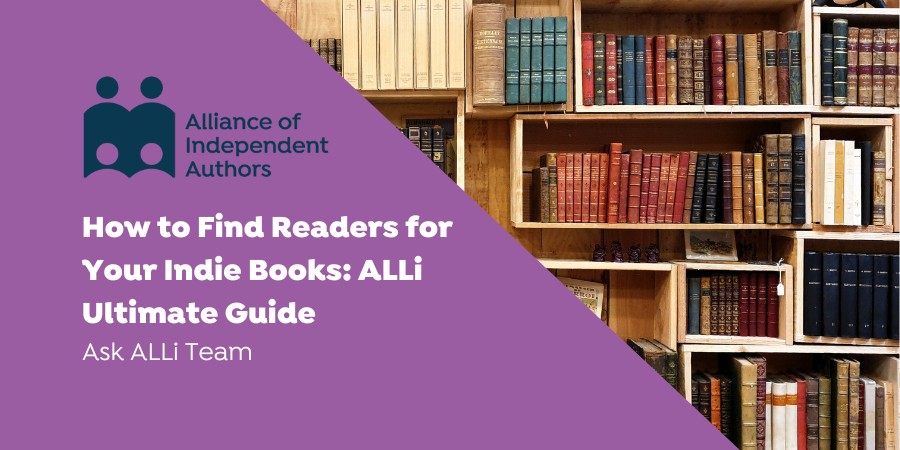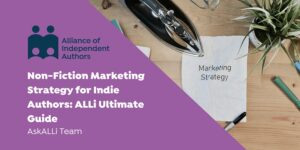Congratulations, you've published your book! It's a remarkable achievement, but the journey doesn't end there. In the ever-evolving world of independent publishing, the key to commercial success lies in finding readers to build a loyal following who will pick up your books time and time again.
The Alliance of Independent Authors (ALLi) has been at the forefront of supporting indie authors to connect with their readers, and in this guidance, we'll delve into strategies that can help you discover a treasure trove of readers for your self-published books.
This post is particularly targeted at our members who are early on in their writing journey, but hopefully the tips included here will support authors of all levels of experience to consider how to further increase your loyal readership.

Photo by Eliott Reyna on Unsplash
1: Understand Your Reader and Your Market
Define Your Ideal Reader
Finding readers involves understanding them first. Start by defining your ideal reader persona, thinking about them from all angles.
Ask yourself:
- Are any demographics relevant – such as age group?
- What genres, themes, characters, places to they enjoy reading about?
- What are your reader’s inner attributes – their beliefs and goals, or fears and worries?
- How might they spend their spare time – where are they, what are they doing, what are they interested in?
- Who do they trust – who or what influences their beliefs and actions?
- How do they like to read – what devices or formats do they use, and where do they go to buy their books?
How do you answer these questions? You can do this by looking at similar books on the market (see below), exploring communities your readers use, such as online forums, or taking a look at demographic data from your target countries. If you have a small number of followers already, you could also run a quick pole to ask some key questions.
If you really want to understand your target reader, you could write a few short pen portraits of people from your the key reader groups you've identified. Giving them a profile and even a name can help you picture your readers and plan how you will reach them effectively.
Explore your market
As with any good business, understanding your competitors and the landscape in which you are operating can give you the edge. You can utilize online data, such as Amazon's Best Sellers and Goodreads, to analyze books in your niche and find your readers.
Take note of:
- What books are popular in your genre or topic area?
- Who are the successful indie authors in your niche?
- What keywords and phrases are frequently used in similar book descriptions and titles?
- What is trending amongst competitor authors and their followers on social media?
- What is listed in the ‘people who bought this also bought’ list beneath competitor books?
Understanding how your book fits into the market and what your readers are searching for will help you plan how to position your own work so that it can be found by the right people in the right places.

Sacha Black
2: Deliver your reader expectations
Now this is a tricky one. Not everyone likes the idea of adapting your writing style or narratives to fit the readers’ expectations, also known as ‘writing to market’. However, many of our members have found that understanding your chosen genre, and actively writing to fulfil the wishes of readers, can increase your chances of building your own loyal following.
It's a decision each author needs to take for themselves. But, if you are looking to ‘write to market', indie author and ALLi team member, Sacha Black, has some tips to share. Sacha specifically changed her genre and approach for her most recent series under a new pen name.
Key steps Sasha took to prepare for this shift are:
- I spent a long time studying the market. Not just one afternoon, but over weeks. If a book has had a big advertising push, we can mistakenly assume it's a bestseller over the long term rather than one in the midst of a promotion. You want to understand which books are consistently at the top of the charts, not ones that are hit with a one-off promo then sink into obscurity again.
- Added to this, I bought and read K-Lytics reports on the fantasy romance market. These reports back up your own research and are incredibly in depth. This gave me the starting point for my reading. There is a cost to this, but if you feel the benefits from the information outweigh the investment, it might be right for you.
- While all my other books are wide, I wanted to try writing a series specifically for KU. So the majority of the competitors I searched up and read were KU books.
- Of the books I felt were the closest to what I wanted to write, I studied their 5* and 3* reviews. What did readers say the author consistently got right? What did the 3* reviews say they missed? I wanted to know so I could try to adapt and fix it in my own books.
- I picked out common tropes readers kept using, book lengths, style of writing / pace / POV / level of snark etc, brand colours. Whether there were symbols or people or other things on the covers. I needed to know every single element and aspect of what was selling in the genre.
- Of the authors selling well (and consistently) I then examined their social media. What were the particular platforms they were using? Did they favour FB ads or AMS, or something else entirely?
- Last, I collected a large quantity of comp books and authors from all of this research – keeping them categorised by various elements.
And don't forget…
Reader expectation begins before a buyer opens your book. Whether you are taking this ‘write to market’ approach or not, ensuring your cover and blurb is professional, appealing to your target audience, and representative of your genre or non-fiction topic is critical to ensure readers take the leap and pick up your book over all others.
3: Speak to Your Readers Through Trusted Voices

Photo by aboodi vesakaran on Unsplash
Marketing across all sectors increasingly uses partnerships and influencers to speak to the groups they are trying to reach, and indie authors can utilise this tactic to find readers for your books.
Authentic connections with those who your audience already trusts and engages with can be a powerful way of communicating with potential readers who will connect to your work. A few ways this can be done are:
-
Connect with Book Bloggers
Reach out to book bloggers in your genre and offer them a free copy of your book in exchange for an honest blog post about your work and ideally posting reviews. Book bloggers will be passionate about your genre and will speak to others who feel the same. Make sure you do your research to work with the right people in your niche.
-
Collaborate with Fellow Authors
Through local and online author groups and organizations, you can connect with other indie authors already speaking to your readership. Sharing tips, information and strategies for reaching your shared readers can be great for connecting and improving your plans. Crucially, you can also cross-promote each other's work, for example sharing book launch information with mailing list groups or interviewing one another for blog posts. It may seem counterintuitive to promote a competitor, however, for many genres and topics, your readers will complete several books a week and will be hungry for more similar work, so working together with people in your niche to fulfil that demand can be very effective. A similar process happens through groups such as Bookfunnel, where authors work together to produce materials promoting each other’s work based around shared genres or topics, and you may want to invest in this too.
-
Contribute to Anthologies and Box Sets
For some genres, collaborating with other authors to create anthologies or box sets can be effective for reaching new audiences. Those who pick up the work because they are interested in one author will then find your name inside too, and be introduced to what your books can offer, expanding your reach to new readers.
-
Explore Promotions
You could consider applying for promotions such as with BookBub to reach a large audience of avid readers that targets those interested in your genre. Sites such as Goodreads also run author programs, where you can create giveaways, and engage with readers in book groups and forums, targeting those you’ve identified in your earlier reader research.
-
Take Part in Events for Finding Readers
Taking part in virtual and local events that reach your readers, such as book fairs, author conferences or book signings, not only links you to new readers, but to other authors and those in the indie author community who can share your book more widely.
-
Don’t Forget Your Readers’ Favourite Platforms
Optimizing your book's presence on platforms such as Amazon by using relevant keywords and compelling book descriptions that highlight what your readers will be searching for is critical. The correct information will ensure it comes up in a potential reader’s search results and be suggested to those already buying books from similar authors. Don't rush that critical step when launching your book.

Photo by Myriam Jessier on Unsplash
4: Drive continual traffic back to your books
Building a presence online that directs potential readers back to your books at every turn increases the likelihood of a sale.
When someone finds positive content, comments, or information about you and is intrigued by what you have to say, directing them straight back to a professional author website (your online hub for you and your work) or sales page is important.
Consider placing sign-posting content, such as short videos about your work, reviews of books in your genre, writing tips or other useful information you can share, across different platforms. Your plan might include activity such as:
-
Engaging on Social Media
If they are right for your readership, use social media platforms like Facebook, X (Twitter), Instagram, and TikTok to connect with potential readers. Share content related to your book, engage with your audience, and direct people on to your own platforms. (A little more to consider when deciding how much time to dedicate to social media is below, in our Social Media Myth Busting information!)
-
Building an Email List
Collect email addresses from your website visitors and social media followers (following all GDPR or similar data protection guidance) to continue to engage with them. Your email list is where you collect the details of your committed readers and ensure continued conversations with them for key milestones on your author journey. Your list will start small but will build as your career progresses.
-
Considering Using Reader Magnets
A big incentive for readers to subscribe to your regular mailers is to offer what is often called a “reader magnet”. This is a free piece of content related to your books, which can only be accessed by subscribing. It could be in text, audio, or video format. But whatever you offer must align closely with the books or products you want them to buy. For fiction, this is often a short story or novella, perhaps expanding a side character or introducing a backstory for a main character. For non-fiction, a workbook, planner, or information expanding a topic in your book can work well.
-
Sending Regular Newsletters
Your website provider may include a newsletter functionality, or there are many providers are out there that offer a ‘plug-in' or link you can add to your site quickly and easily. There is a useful comparison tool here where you can add or remove providers to compare.
Keen readers will expect regular contact. Plan your emails to a schedule; this helps continue to build trust with your audience. The emails should be written in a way that replicates and reinforces the writing style of your books. Your readers should look forward to opening your emails. They should feel valued when they read what you have to say, as if they have access to something special that comes direct from you, the author, to them.
Social Media Myth Busting!
Using your time wisely when reaching out to your readers is important. But, you can easily head into a rabbit hole of activity that may give little back in terms of actual sales, particularly in the world of social media.
One key myth around audience reach that may help keep you on track is… “social media sells books”. This isn't (always) the case.
One reason social media is misunderstood is because it mimics one of the primary things authors need: visibility. It can make you feel seen because you receive comments and likes. But you're being seen on a platform that is saturated with different voices and messages, and that critically doesn't allow direct purchases of your books (in the vast majority of cases). If you take a platform like instagram, you have to direct people to a story or to your profile before they can reach a clickable link. Any friction or additional step between the user and your book means losing potential sales.
So what is social media for?
Social media is a platform for growing your brand, building trust with readers and encouraging your following to move across to your owned platform— your website and mailing list.
Can you get some sales from social media? Yes, of course. But if the effort and time spent on social media directs you away from other sales activity, you may want to reconsider. In most cases, you're more likely to get sales from the same time spent advertising on Amazon or Kobo or any of the other store websites than you are from social media activity. Of course there's a cost to that, which is why social media is great as a free, slower-growth platform. It's up to you as the author to weight up your time and budget across the options available, but if you are tight on time, think carefully about what to prioritise. You can test different approaches to see what works best for the time and budget you can commit.
5: Stay Informed, Experiment, Adapt

Photo by Brett Jordan on Unsplash
The world of indie publishing is continually evolving. Stay up-to-date on the latest trends, marketing strategies, and tools for authors and don’t be afraid to try something new to help you find readers (and keep them).
Regularly analyze the results of what you have done and adapt your strategy accordingly. If you find a reader magnet is particularly successful, focus time on promoting it across more channels. If you have a great response to a blog post or an ad, look at why people loved it and do more of the same. Finding one social media channel has more engagement than others? Ask yourself why, and whether you should focus more time here and less time elsewhere.
Keeping up to date with the different techniques available to you can be as easy as joining the relevant social media groups discussing your work, and dropping in regularly to the ALLi blog and ALLi podcast to stay abreast of any changes and hear regularly from successful indie authors about what is working for them.
Top tips from our members
Are you part of our Alli Author Member Forum? This online space, exclusively for ALLi members, is dedicated to discussions regarding self-publishing. Whatever your question, you will find useful comments and posts from our members to help on the forum.
A recent thread on finding readers brought up some great member tips, and we’re sharing some edited posts and comments from that discussion here:
Kevin Partner, author of speculative fiction, had four top tips to share for reaching his readers by:
- researching the various markets and finding those that suit what I want to write
- writing reader magnets for each series and joining group promos with Bookfunnel to build a newsletter audience
- writing newsletters attractive to my audience, so my mailing list remains healthy and responsive
- when I launch a new series, advertise book one heavily and set it to .99 so potential readers will give me a try
Lesley Krier Tither, author of the Ted Darling Crime Series, has found success through Facebook:
“I get great ROI (Return On Investment) from my FB group specifically for readers of my crime fiction. Loads of interaction, members convert their friends to the series, and, just as importantly, I really enjoy the craic, too. It's a lot of work, but for me it is well worth it.”
Melissa Addey identified her audience was very similar to her and used this insight to plan her targeting strategy:
“I’ve found it interesting that because I write stories I want to read, my readers (when I saw advertising stats etc) turn out to be very similar to me and that makes finding and communicating with them easier because you can think about where you yourself would be online, what you’d like from a newsletter, etc.”
Stacey Deane made the point that quality writing, consistent delivery and patience can be key in building an audience, particularly when you are just starting out:
“Write books people not only enjoy but can't put down! Books that are so good if the house was on fire they'd keep reading. This other stuff, conferences, classes, conventions, none of that will do anything for you if you can't get readers hooked on your books so remember that writing and publishing consistently (and not disappearing for months or years in between releases) gives you a better shot. You also gotta be patient. If you are new, it takes time. The trick is to get better and better at the process with each book.”
Conclusion
Finding a loyal readership for your self-published books is a journey that requires dedication, patience, and a strategic approach.
By defining your target audience, understanding your market, and collaborating with others in your genre, you can increase your book's visibility and attract a dedicated readership.
Remember, the key to success in self-publishing is a combination of great writing, effective marketing, and patience.
For more tips and strategies for growing your readership, don't forget to look back at our backlist of blogs on processes five (marketing) and six (promotion) from the seven processes of publishing.
For non-fiction writers in particular, don’t miss our recent ultimate guide to developing your marketing strategy, including more ideas for non-fiction reader magnets.






Very informative. Useful tips about social media. How to maintain interest for your writing. Apart from aiming for at least one book a year, sometimes two, I aim to help keep reader interest. Also, work hard at writing commentary or producing a short story or poem for my blog site weekly. It all can help. After publishing eleven books, I now receive messages from journals and libraries interested to know about my latest book. The deafening silence after publication is no longer so audible?
Wow – what an amazing and comprehensive resource for any author. This is such a smart way to approach publishing a book (and it shows how patience is definitely a requirement for success)! Thanks so much for putting this out there.